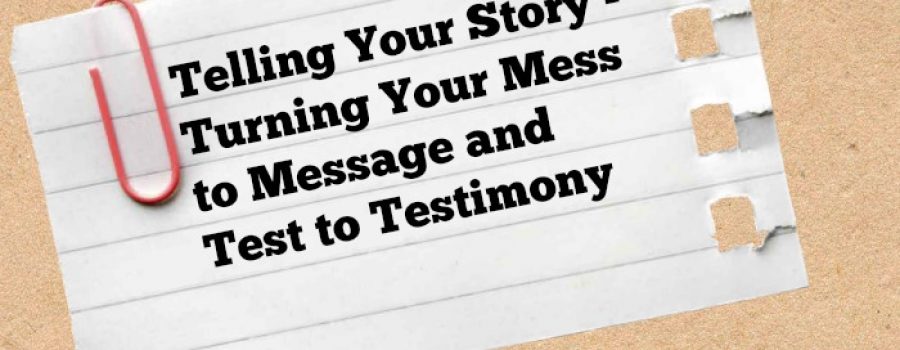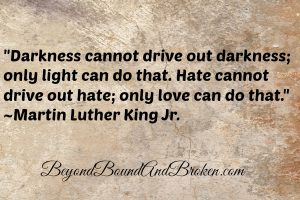“You have a story to tell. Someone needs to hear your story and only you can help that person.”
In 2013, I heard Les Brown say those words. There were hundreds of people in the room, but it felt like he was talking only to me. I knew I had a story to tell – but I didn’t want to tell it. I hadn’t talked about it for 13 years, and I didn’t want to start now.
But, those words are powerful. It took me six months to overcome the fear, shame, and hurt from my past, but I knew, if someone could be helped by me telling my story, even one person, it would be worth it.
A little more than three years later, I’m now a full time speaker, author of 7 books, and a coach. I learned to tell my story, and I’ve shared the stage with some of the greatest motivational speakers – Les Brown and John Maxwell. I share my story to inspire hope for others, and I coach other people to share their own story.
I talk to many people, all at different stages of learning to tell their own story, turning a mess to a message and a test to a testimony. I offer one-on-one coaching in my Storyteller Program or just a one time session, but if you aren’t ready for either of those yet, here are some ways you can get started sharing your story!
1) Refine your message
This takes time and a lot of thought. Start by journaling on a blank notebook your experiences – good and bad, your special gifts, your unique qualities. The idea here is to list out what makes you YOU. Next, spend some quiet time reflecting on what lessons can be learned from your life, your mess, or your test. What are the stories that you are ready to share? What are the powerful lessons that can be learned from your life? What mistakes have you made? What have you learned from those mistakes? What is the overall point or single takeaway that you want to share based off of who you are?
This process takes some time, and you will likely continue to refine your message over several months or even years. I love coaching clients through this process because it’s a journey of self-discovery! This is part of building your brand. Don’t try to shortcut it.
2) Build your content
Start your collection of stories, quotes, and points to talk about. You can do this on good ol’ fashioned paper and folders by topic, or you can do it electronically. You could create an Excel spreadsheet with tabs by topic. I personally use Evernote, and I keep a note for each subject that contains great quotes I’ve collected over the years. Evernote allows you to search, which doesn’t seem like a big deal now, but when you get thousands of quotes or stories, it will be really helpful. Evernote also can sync between your smart phone and laptop or you can access an online account, so it’s really flexible and stored in the cloud. There are many other apps or electronic filing systems so spend some time searching for the one that fits you and how you like to work. It has to be easy, accessible, and comfortable or you won’t use it.
Once you have some base stories, quotes, and points, you can start building your own content. Start blogging or posting quotes on your social media network. I personally create a blog and post it both on my LinkedIn network as an article and on my website as a blog. Repurposing the content allows you to maximize your time and energy and reach more people. Some blogs have ended up as chapters in my books or turned into workshops when I speak.
3) Spread the word(s)
Start speaking and sharing your message. Speak at Kiwanis clubs, Rotary clubs, or community events. That will help you get some experience, gain some practice, and start collecting some testimonials. You will know you are getting there when people come up to you afterward and share how your message impacted them! If/when you are ready to go pro, there are websites that allow you to register as a speaker, such as SpeakerMatch.com or Gigsalad.com. Those require an investment to be listed, so they aren’t for the “just dipping your toe in” speaker.
I highly recommend to my clients that they go ahead and reserve their name domain. (such as www.RiaStory.com or company name, such as www.TopStoryLeadership.com), even if they aren’t ready to use it yet. Go to GoDaddy.com or another domain registrar and get an account and buy “YOURNAME” domain name. That way, when you have a large social media following, you can continue to expand your platform and you will already have your domain. You can even start your own website or have someone build it for you if you are ready to invest a few dollars and a little time. This is great to have because, as you build your brand, you need a website to drive traffic to, and you would rather have a full website rather than trying to solely use your Facebook profile or LinkedIn profile. Another benefit to a website is at some point you can have a store and offer e-commerce products for sale, which becomes a revenue stream.
I post a lot of picture quotes or memes because they get a lot of interaction on social media. It’s a great way to inspire people, share your message, and reach out to people. “A picture is worth a thousand words….” and that’s multiplied by one thousand when it comes to social media. There are a ton of picture quote sites or apps out there. I have tried a few, and my favorite is PicMonkey.com. They have a free option or the premium option is very reasonable. You can edit pictures, add quotes, or create your own and don’t forget to include your new website at the bottom.
Always make sure that you credit the person who said it, and/or if you are generating revenue from an image, file, or someone else’s intellectual property, make sure that you have license to do so. (123rf.com is a good source for royalty free images, video, and sound, and it’s very reasonable.) Sure, there isn’t much new under the sun, but if you are inspired by a really great quote, make sure to let everyone know who said it! Or, if you found the perfect picture for your new book cover, go buy the license to use it!
4) Put your story into a book
Not everyone is going to be offered a six figure publishing deal simply because they are ready to tell their story. So what? Self-publishing is easy, affordable, and a great way to help you build your platform. It’s a revenue stream, a credibility booster, and a resource for people who hear you speak and want to learn more. It’s also a way to reach other people who may never get to hear you tell your story in person.
I use Createspace.com, which is an Amazon affiliate. It has a step-by-step guide to walk you through the entire process. You download their template, upload your finished file, and you can do a very basic cover, all at no cost. You will have to purchase an ISBN number if you want your own, or you can use one assigned to you if you don’t mind Createspace being listed as the publisher (no cost). They offer a la carte services such as cover design or editing, or you can do all of it yourself. I create my book covers in Microsoft Word (see some examples here), or you could use a photoshop software. Createspace offers a “Cover Creator” that is very easy to use and builds off templates that you customize. Of course, there are other self-publishing companies out there, and some offer hard-cover options. Please remember that this isn’t a post telling you the ONLY way to tell your story. I’m simply sharing ONE way you can tell your story.
There are lots of ways to write your book. I like to suggest to my clients that they think about a book outline first, and I suggest they consider three types of stories to include: a) “Who am I” stories that tell what makes you who you are; b) “Why am I here” stories that share your purpose; and c) “What I can do for you” stories that share lessons learned, principles taught, tips, powerful points, etc.
I personally like short chapters and small books, because the feedback I have received is that readers prefer short chapters and easy to read books that aren’t intimidating.
Hopefully this gives you an overview of how to get started. Need inspiration? View the link below and listen to Morgan Harper Nichols’ inspirational video “Storyteller.” Then, if you need more info, sign up for my one-on-one coaching & mentoring session or Storyteller Program. Don’t wait for the perfect time. Just get started! Zig Ziglar said it best, “You don’t have to be great to start, but you have to start to be great.”
https://www.youtube.com/watch?v=xID_t–BrqE
About the author: Like many, Ria faced adversity in life. Raised on an isolated farm in Alabama, she was sexually abused by her father from age 12 – 19. Desperate to escape, she left home at 19 without a job, a car, or even a high school diploma. Ria went on to thrive. She worked her way through school, an MBA, and a successful career in the corporate world of administrative healthcare.
Now a full time leadership motivational speaker, coach, and author of 7 books, Ria co-founded Top Story Leadership, a consulting company offering keynote speaking, leadership training, and coaching.



